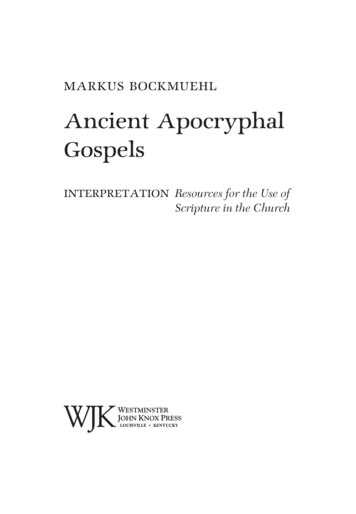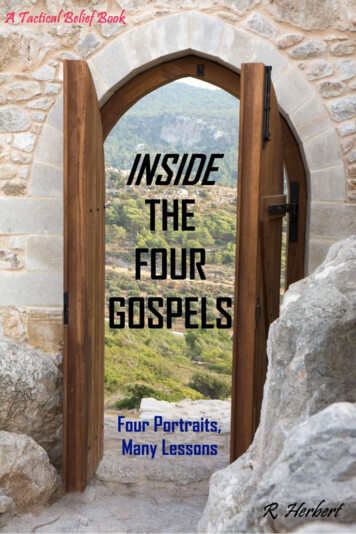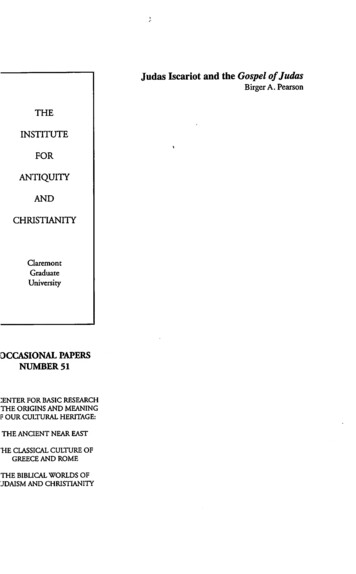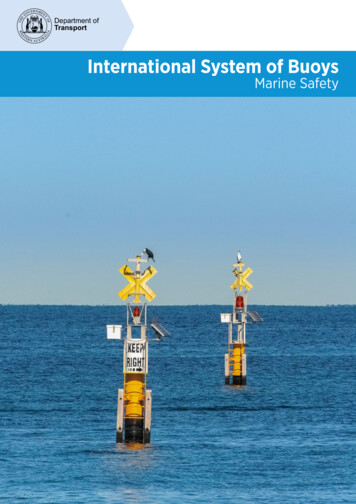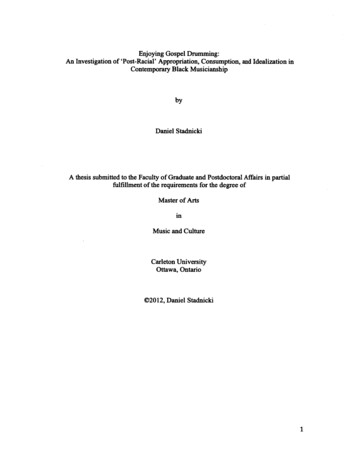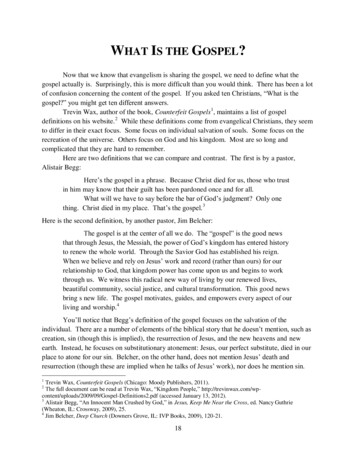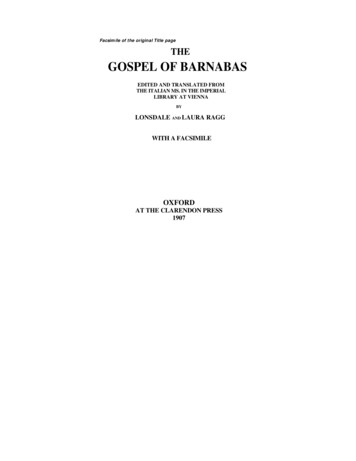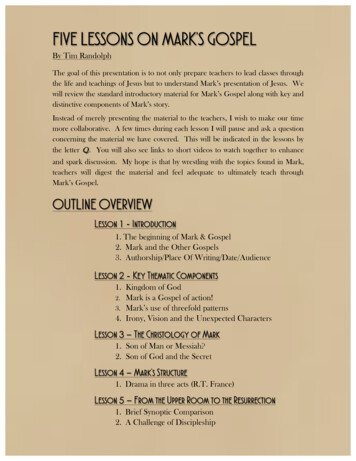
Transcription
FIVE LESSONS ON MARK’S GOSPELBy Tim Randolph!The goal of this presentation is to not only prepare teachers to lead classes throughthe life and teachings of Jesus but to understand Mark’s presentation of Jesus. Wewill review the standard introductory material for Mark’s Gospel along with key anddistinctive components of Mark’s story.Instead of merely presenting the material to the teachers, I wish to make our timemore collaborative. A few times during each lesson I will pause and ask a questionconcerning the material we have covered. This will be indicated in the lessons bythe letter Q . You will also see links to short videos to watch together to enhanceand spark discussion. My hope is that by wrestling with the topics found in Mark,teachers will digest the material and feel adequate to ultimately teach throughMark’s Gospel.OUTLINE OVERVIEWLESSON 1!"!INTRODUcTiON1. The beginning of Mark & Gospel2. Mark and the Other Gospels3. Authorship/Place Of Writing/Date/AudienceLESSON 2 - KEY THEmaTic COmPONENTS1. Kingdom of God2. Mark is a Gospel of action!3. Mark’s use of threefold patterns4. Irony, Vision and the Unexpected CharactersLESSON 3!–!THE CHRiSTOlOGY OF MaRK1. Son of Man or Messiah?2. Son of God and the SecretLESSON 4!–!MaRK’S STRUcTURE1. Drama in three acts (R.T. France)LESSON 5 –!FROm THE UPPER ROOm TO THE RESURREcTiON!!1. Brief Synoptic Comparison2. A Challenge of Discipleship
LESSON 1 - INTRODUcTiONThe purpose of Lesson 1 is to answer introductory questions regarding the nature ofthe Gospel according to Mark. We will get a feel for where Mark is taking us.I. The beginning of Mark & The GospelA. Mark’s story begins “The beginning of the good news of JesusChrist, the Son of God.”1Q – What is a Gospel? What is the good news? Is it limited to Jesus’crucifixion and resurrection? Is it significant that Mark places this line atthe beginning of his story?Watch this video - http://youtu.be/ICHovRHJAYYIf you can, watch the entire video but if there are time constraintswatch from minute 1:12 to 8:43.B. Mark begins at Jesus’ baptism (Read Mark 1:1-12 together)1. Lacks a birth narrative.a. Moves straight to Jesus’ ministry.Q – Why would Mark skip to Jesus’ Ministry?II. Mark and the Other GospelsA. Synoptic1. Means – “Seeing together”a. A new Christian in our congregation was reading the NewTestament for the first time. He expressed curiosity by askingme, “Why do the gospels sound the same? I swear Tim, thisLuke guy is the same person as Mark!”Q – Why do you think the canon includes three gospels that share suchan identical story?2. Each Gospel writer had a different audience.a. Matthew is written to display a Jewish Messiah who fulfills theprophecy of the Old Testament. – (Read Matthew 5:17)b. Luke is written to show Jesus’ ministry to the Gentiles. – (Readthe story of Simeon in Luke 2:25-32)c. Mark is written to Gentiles—possibly to Rome? (We will discussthis in more detail under !!!!!!!!!!!1The HarperCollins Study Bible: New Revised Standard Version, with the Apocryphal/!Deuterocanonical Books, edited by Wayne A. Meeks, (New York: HarperCollins, 1993).All Scripture quotations are from the New Revised Standard Version.
B. Who wrote 1st? Matthew or Mark? (Handout #1)1. Traditionally attributed to Matthew. St. Augustine believed thatMatthew wrote first then Mark borrowed from Matthew.22. Modern scholarship mostly holds to a Markan priority. Due toMark’s brevity in comparison to the other Gospels and theamount of Markan material found in the other Synoptic writings,the Hypothesis is that Matthew and Luke use Mark’s narrative.a. Discuss Handout #1.Q – Obviously we are hypothesizing about who wrote first, but what do youthink? What makes sense? Do you think this matters?III.Authorship/Place Of Writing/Date/AudienceA. The Author is never stated in the text.1. Large works such as Mark were seldom distributedanonymously. A title (the Gospel According to Mark) wasplaced on the text at a very early period of circulation.32. Traditionally attributed to John Mark (read the texts together)a. Acts 12:12.b. Colossians 4:10.c. 1 Peter 5:13B. It is unknown where Mark wrote his Gospel.1. Possibly Rome, maybe Alexandria or Galilee? —Somewhere inthe Mediterranean world.42. 1 Peter 5:13 locates Mark in Babylon (Rome).C. The dating of Mark is disputed.1. One internal clue might be found in Mark 13 (Read Mark 13:18,14) – However, Jesus is speaking apocalyptically referencing theO.T.5a. Roman Jewish war late 60’s to mid 70’s CE. so possibly writtensome time !!!!!!!!!!!!2D. A. Carson, Douglas J. Moo. An Introduction to the New Testament. 2nd ed. (Grand Rapids:Zondervan, 2005), 93.3Craig S. Keener, The IVP Bible Background Commentary: New Testament, 2nd ed, (DownersGrove, Ill: InterVarsity, 2014), 126.4Ibid, 126.5Donald Guthrie, New Testament Introduction, 3rd ed, (Downers Grove, Ill: InterVarsity,1970), 73-74.6Joel Marcus, Mark 1-8, Anchor Bible, (New York: Doubleday, 1999), 37-38.
D. Audience1. Likely a Gentile audience—possibly the church in Rome?a. Mark fees the need to explain Jewish semantics (Read 3:17; 5:41;7:11)b. Use of Roman expressions (Read12:42, & 15:16)NEXT LESSON - We will look at a few of Mark’s themes.
LESSON 2 - KEY THEmaTic COmPONENTSThe purpose of Lesson 2 is to highlight key themes and distinctive components in theGospel according to Mark. The goal is to be mindful of the theological devices used byMark to convey the message of Jesus and to tell his story.(To begin this lesson read Mark chapter 1 in its entirety.)I. The Kingdom of GodA. Highlight Mark 1:14-15.Q – What is the Kingdom of God?Watch this video together - http://youtu.be/yNh0z36LsA0?t 8m30sThe video should start at minute 8:30. Jesus scholar MarcusBorg discusses the implications of the Kingdom of God.Q – When you read or hear “Kingdom of God,” do you think about this termhaving religious/political implications rather than just a personal meaningbetween God and his people?B. We will address this in more detail in our next lesson - CHRiSTOlOGY.II. Mark is a Gospel of action!A. Highlight the use of immediately in the first chapter (v. 12; 18; 20)1. εὐθύς - “Immediately” used 41 times by Mark. Used 51 times inthe N.T.!7 εὐθύς is used 11 times in the first chapter alone!Some translations use “At once” or “without delay”.a. Covers a lot of ground in just the first chapter!b. Considerably shorter than the other Gospel accounts.B. Mark uses the historical present over 150 times instead of the pasttense.8 – This keeps the story vivid and !!!!!!!!!!!!!78Joel Marcus, Mark 1-8, Anchor Bible, (New York: Doubleday, 1999), 159.William L. Lane, Commentary on the Gospel of Mark, New International Commentary on theNew Testament, (Grand Rapids: Eerdmans, 1974), 26.
III. Mark’s use of threefold patterns9(Here are a few key examples)A. Three seed parables1. 4:1-9 – The sower2. 4:26-29 – Growing seeds3. 4:30-32 – Mustard seedB. Jesus predicts his death and resurrection three times1. 8:31 – First prediction2. 9:31 – Second prediction3. 10:33-34 – Third predictionC. Peter’s Denial1. 14:66-72D. Jesus announced as Son of God. (Excluding the demoniac confessions)1. 1:11 – Jesus’ baptism2. 9:7 – The Transfiguration3. 15:39 – The Centurion’s confessionE. Even Mark’s Gospel is broken up into three distinct sections. Wewill look at this in more detail in our 4th lesson – MaRK’S STRUcTURE.IV. Irony, Vision and Unexpected CharactersA. Throughout Mark’s Gospel those who should see Jesus cannot,while those least expected can see.1. Jesus family – Read 3:20-35a. Jesus’ inside teachingb. Family is outside (outside of understanding?)2. His disciples – Read 8:11-33a. The disciples are confused about the bread – v. !!!!!!!!!9Luke Timothy Johnson, The Writings of the New Testament: An Interpretation, 3rd ed,(Minneapolis: Fortress Press, 2010), 147-8.!
b. Jesus says, “Do you have eyes, and fail to see?” – v. 18c. Jesus heals the blind man at Bethsaida and he “saw everythingclearly.” – v. 25.d. Peter confesses! Does he see? – v. 29.e. Jesus predicts his death and Peter rebukes. Peter still doesn’tfully see. – v. 31-33.3. The religious – Read 1:21-28a. Those in the synagogue are amazed and confused at Jesus’healing power. – v. 22, 27.b. A man with an unclean spirit confesses that Jesus is the “Holyone of God.” – v. 24. (More on Jesus’ request to “be quiet” in ournext lesson.)i. Note that among the religious the Pharisees persistentlystruggle with blindness. – Read 8:10-11. After Jesusmultiplies bread for the 4,000 (a sign) the Pharisees ask for a sign.Q – What do you think is the purpose of these stylistic components? Is it okthat Mark stylistically structures his story for theological purposes?NEXT LESSON - We will look at Mark’s Christology.
LESSON 3 – THE CHRiSTOlOGY OF MaRKThe Goal of Lesson 3 is to review the titles given to Jesus in Mark’s story. A betterunderstanding of Mark’s use of titles for Jesus will help the teacher comprehend theGospel’s theological purposes.I. Messiah or Son of Man?We began our last session discussing the importance of the Kingdom of God. This tiesnicely to our discussion about the Messiah.A. Messiah1. Literally means “anointed one”a. Christ is the Greek term meaning Messiah.i. Christ/Messiah is a title given to Jesus. It has transformedinto a proper name.2. Read 1 Samuel 16:1-13.a. Act of anointing (Messiah) has kingly implications. (Mark 15:32)b. Messianic language had Davidic connotations.i. Root of Jesse – (Read Isaiah 11; Jeremiah 23:5)3. Expectationsa. During the time of Jesus there were various speculations onthe coming of the messiah.i. Numerous messianic movements and political movements.10ii. Expectations were high!b. Messiah as restorer!i. David, the first great king, plans to build the Temple forthe Lord. The messiah to come will be a rebuilder of thetemple and restore Israel to her former glory.114. Take another look at Mark 8:27-33.a. Peter confesses, “You are the messiah.”b. Jesus explains the plan—to suffer and be killed.c. Peter rebukes his messianic vision.i. Peter’s expectations do not fit Jesus’ vision.ii. This is a good place to recognize another title given toJesus in Mark—Son of David. (Mark 10:47-48) This isclearly recognition of !!!!!!!!!!!!!!!!!!10N.T. Wright, Jesus and the Victory of God, Christian Origins and the Question of God, Vol. 2,(Minneapolis: Fortress Press, 1996), 482.11Ibid, 483-84.
B. Son of Man1. A title used by Jesus.a. Read Daniel 7:13-14i. Representative of God and a man—member of the humanrace.122. Jesus often shifts attention to “Son of Man” after talk of Messiah.a. Mark 8:38i. After Peter confesses Jesus as Messiahb. Mark 14:62i. After the Council asked if he was the Messiahc. Mark 13:26i. After the cleansing of the temple and the prediction of thetemples destruction. Such action was consideredMessianic.Q – Which is it? Is Jesus the Messiah or the Son of Man?Watch this video together - http://youtu.be/WXQbBhNSkHsQ – How does Jesus’s vision of the Son of Man fit with his vision of Messiah?II. Son of God and the SecretA. The use of the Son of God1. By the demoniaca. Read 3:11-12i. Wherever unclean spirits saw him!b. Read 5:7- 8i. Do not torment me recognized Jesus’ powerii. Legion uses “Son of the Most High God.” In 1:24-25the man with the unclean spirit calls him “the holy Oneof God”2. Messianica. Mark 1:1i. The story about the Messiah, Son of !!!!!!!!!!12Marcus, 528.!
b. Mark 15:61-62i. Jesus confesses (I AM) to the question of being theMessiah son of the Blessed one.3. Divine? (review the triad confessions)a. His baptism –The voice of God (Mark 1:11)b. The Transfiguration – The voice of God (Mark 9:37)c. The Cross – The Centurion (Mark 15:39)i. The 1st human confession.d. Paul?i Read Romans 8:3; Galatians 4:4e. Old Testament?i. Read Psalm 2:7; Psalm 110 (see Mark 12:35-37)B. The Secret1. Messianic Secret?13a. Jesus quiets Bartimaeus for calling him Son of David. (As wejust read)b. Most call him Son of God/ Holy one of God.ii. As we read the Son of God confessions by the demoniacsJesus tells them to be quiet after they reveal his identity.Q – Why do you think Jesus wanted to keep his identity privateearly in his ministry?iii. Jesus’ identity cannot truly be known until he isglorified.14 – Read 15:38-39 and 9:9.We will return to the question of the secret and the thematic issue of visionwhen we get to lesson 5 - FROm THE UPPER ROOm TO THE RESURREcTiONNEXT LESSON - We will look at how Mark structures his !!!!!!!!!!!!13Jack Dean Kingsbury, The Christology of Mark’s Gospel, (Philadelphia: Fortress Press, 1983), 123. Kingsbury is critical of William Wrede’s “Messianic Secret”, and is more appropriately a secret abouthis identity as the Son of God.!14Marcus, 526
LESSON 4!–!MaRK’S STRUcTUREThe purpose of Lesson 4 is to get a feel for the overall structure of Mark’s Gospel. Nowthat we’ve discussed key themes and components along with the Christology of this Gospel,we see how Mark constructs his story to communicate his message of Jesus.I. Drama in Three Acts15 (Handout # 2)A. Scholar R. T. France has done an excellent job with Mark’sstructure. It is to be noted that Mark’s Gospel is moving towardsJerusalem—ultimately the cross.1. Galilee – 1:14-8:21a. After a brief prologue, Jesus does the bulk of his publicministry in the Galilean region among non-Jewish people.16i. “Mark’s aim [is] to lead us to understand how themessianic mission of the Son of God, set out in theologicalperspective in the prologue, was worked out in practiceamong the inhabitance of the villages and smaller towns ofGalilee.”172. “On The Way” To Jerusalem – 8:22–10:52a. The story begins to intensify and focus its sights on Jerusalem.i. 8:31 – Jesus predicts his suffering at the hands of the“elders, chief priests and scribes” – In Jerusalem.ii. The failure to see the kingdom and Jesus’ planintensifies among the disciples and Jesus’ opponents.b. Less public ministryi. Only a few healings (8:22-26; 9:14-29; 10:45-52)ii. Private instruction with Disciplesc. ἐν τῇ ὁδῷ & εἰς ὁδὸν – “on the way”i. (Read 8:27; 9:33-34; 10:17, 32, 52)ii. Geographical movementiii. Discipleship as a !!!!!!!!!!!!!!!!15R.T. France, The Gospel of Mark: A Commentary on the Greek Text, New International GreekTestament Commentary, (Grand Rapids: Eerdmans, 2002), 11-15.!16Ibid,!88.!1718Ibid, 89.Ibid, 320.
3. Jerusalem – 11:1–18:8a. 11:1 – Approaching Jerusalem – First time in Jerusalem.b. Healings finished – only one miracle.i. Cursing the fig tree- negative not positive – a propheticjudgment.c. Prophetic actionsi. Entering Jerusalem - Zach. 9:9; Cursing the fig tree Jeremiah 8:13; Cleansing the temple – Isaiah 56:7, Jer. 7:1-11;Little apocalypse/ Son of Man – Dan 7:13-14.ii. Mark 13 serves as France’s second ExplanatoryDiscourse. Allows the “readers to pause and thinkabout the significance of what is being narrated.”19 Seealso Ezk. 40-48.d. Messianici. Though Jerusalem is his place of death it is the city ofDavid. “The Messiah must come to ‘his’ capital andpresent himself to his people.”20B. Notice how the three “Son of God” statements fit nicely within thistriadic structure.1. Jesus’ Baptism – 1:11a. Jesus’ identity is revealed to Jesusi. Jesus’ glory revealed to readersii. Inaugurated his ministry in Galilee2. The Transfiguration – 9:7a. Jesus’ identity is revealed to his disciplesi. Jesus’ glory is revealed to some3. The Cross – 15:39a. A climatic confession—Jesus’ identity & glory revealed to all!i. Compare this full confession to Peter’s half confessionii. Mark’s gospel has led us to this point – finally someonecan see! Identity revealed to the !!!!!!!!!!!!!!!19Ibid, 427.!20Ibid, 426.
C. In addition to France’s Explanatory Discourses I’ve added anemphasis on Jesus’ death predictions. These discourses orconcentrations of teachings21 are used to explain the actions of Jesus.1. Explanatory Discourse 1 - 4:1-34a. This discourse falls in Act 1. Jesus teaches in Parables.i. Jesus teaches about the Kingdom to explain what has beenhappening.ii. Just before – Jesus proclaims the kingdom of God(1:15) and begins to heal.2. Explanatory Discourse 2 - 13:3-35a. This discourse falls in Act 3. Jesus gives us his apocalypticand prophetic vision of the destruction of the temple and theend.i. Jesus answers the disciples question, “Tell us, When ” 13:4.ii. Just before—Jesus curses the fig tree and cleanses thetemple (11:12-19)3. Jesus’ Death Predictionsa. 8:31i. Jesus reveals his planii. Just before—Peter confesses Jesus is the Messiah (8:29)iii. Jesus explains his messianic plan.b. 9:31-32i. Jesus reveals his plan to die a second time.ii. Just before—Jesus is seen in a glorified state at theTransfiguration (9:7), and restores (resurrects?) a boythought to have died (9:26-29)c. 10:33-34i. Jesus reveals his plan to die a third time.ii. Just before—the disciples argue who’s the greatest (9:3337), a rich man refuses to give up his wealth to followJesus (10:17-22), and Peter confesses to giving upeverything to follow Jesus (10:28).Q – What surprises you about the structure of Mark? What is striking? Whydo you think he chooses to construct his story in such a way? How doesMark’s chronology compare with the other 3 Gospels? Why do you thinkthey are different?NEXT LESSON - We will take a closer look at Mark’s !!!!!!!!!!!!!21Ibid, 14.!!
LESSON 5 –!FROm THE UPPER ROOm TO THE RESURREcTiON!The Purpose of Lesson 5 is to review the final days of Jesus and to see how Mark’s endingfunctions as the climax of the story—revealing Jesus as the Son of God. It also serves as achallenge to Mark’s readers—the church in Rome. It is also a challenge to us today!22I. Brief Synoptic Comparison(Because, as most believe, Mark was used for Matthew and Luke’s narrative there isn’ta lot of passion material unique to Mark. A few comparisons are helpful to understandMark’s ending.)A. The Upper Room & Gethsemane1. Both Matthew and Mark foretell Peter’s denial after the Supper(Matthew 26:30-35 & Mark 14:26-31)a. Luke foretells Peter’s denial during the Supper.2. Sleeping in the garden (14:32-42)a. In Mark the disciples appear foolish and weak. – Enough!i. Their eyes are closed to what Jesus is doing.b. In Luke the disciples are grieving – (22:45)i. Sad because they are awareB. Arrest and trial1. Young Man who ran away naked (14:51-52)a. Only mentioned in Marki. Completes the desertersii. Jesus is calm while the disciples run awayiii. Allusion to Judgment of Israel in Amos 2:16?Genesis 39:12?iv. Adam in the garden?2. Only Matthew and Mark include Jesus being interrogated by thepriest’s and elders at night. (Matt. 26:59-66 & Mark 14:55-64)a. Emphasizes Jesus’ sufferingi. Peter is in the distance with a guard!ii. Maximizes Jesus’ loneliness (see below)iii. See also Matthew 27:27-31 and Mark !!!!!!!!!!!!!!22See Lesson 1’s discussion on Mark’s audience.
C. Crucifixion1. Jesus is offered wine as a drug to dull the paina. In Matthew Jesus tastes (27:34)b. In Mark he refuses to taste (15:23i. Jesus fully suffers and feels everything!D. Resurrection1. Mark’s ending is the shortest. Earliest manuscripts end at 16:8.a. Most scholars believe that the longer ending of Mark (16:9-20)is not written by Mark.23i. Missing ending? Intended to end openly?Q – What are the advantages or disadvantages of ending Mark at 16:8?(Read Mark 14-16:8)II. A Challenge of DiscipleshipA. Alone1. Rejected by the religious – 14:1-2a. Plot to Kill (Destroy) Jesus has been brewing since 3:62. Betrayed by Judas – 14:10, 44a. Imagine the deep hurt – It’s one thing to be betrayed by anenemy (the religious) but by one in your inner circle wouldbe difficult to undergo. Hindsight makes us forgetful thatJudas was special to Jesus- called as one of the 12!2. Denied by Peter – 14:29-31, 66-72a. Earlier Peter confesses Jesus is the Messiah – 8:293. Asleep in Gethsemane – 14:32-42a. Can you not keep awake for one hour?i. Asleep/in the dark about Jesus’ glorification.ii. Could you stay awake? When’s the last time you’veprayed an hour?4. Alone in his darkest hour – 14:53-16:8a. Among the counseli. Peter follows at a distance – !!!!!!!!!!!23Joel Marcus, Mark 8-16, Anchor Bible. (New York: Doubleday, 2009), 1088.
b. At the cross and resurrectioni. Only the women are present at the cross (15:40-41) and theresurrection (16:1)ii. Jesus’ apostles (the men) have deserted him – 14:27iii. It is important to note the significance of women inMark’s gospel!The Challenge for the Church: Will you follow Jesus in light of persecution?When the going gets tough, will you follow the Son of God?B. Witness1. There’s nobody left to proclaim Jesus as God’s Son!a. His closest friends have deserted him.2. At the Cross (15:39)a. “Truly this man is God’s Son!”i. The Centurion—non-Jew is the Witness to Jesus’ glory.ii. Finally this is confessed by a human voice!3. At the resurrectiona. The disciples are to meet Jesus in Galilee – 14:28i. The young man dressed in white tells the women that Jesushas gone to Galilee—like he told his followers - 16:7ii. Afraid.b. Told to “go and tell” – 16:7i. Mark ends by saying “they said nothing to anyone, for theywere afraid.” – 16:8ii. Compare to demoniac in 5:2024iii. Jesus tells many demoniacs to be quiet and not tell,but tell anyway. Now his followers are told to telland say nothing.A Challenge to the Church – Will you be a witness to the things you’ve seen andheard?Q – How does the issue of vision play a key literary role in Mark’s story? – Notice inMark’s gospel that only after witnessing the cross and resurrection do his followers fullyunderstand.As we end our study, what is the take-away for you? What is something new that youlearned about Mark’s Gospel? What features do you plan to highlight when you !!!!!!!!!!!!24Luke Timothy Johnson, The Writings of the New Testament: An Interpretation, 3rd ed,(Minneapolis: Fortress Press, 2010), 162.!
Handout # 1!The Synoptic Problem - Who Wrote First?251. Augustinian26Matthew!Mark Matthew & Mark!LukeMatthew wrote first. Mark borrowed from Matthew and Luke borrowed fromboth Matthew and Mark.2. Two-Source HypothesisMark wrote first. Matthew & Luke borrowed their narrative from Mark and theremaining material in Matthew and Luke was borrowed from another source (Q).3. Q-SourceQ (Quelle – “Source”) is primary sayings of Jesus.273. The Farrer HypothesisMark!Matthew Mark & Matthew !LukeA. M. Farrer hypothesizes that Mark wrote first. Matthew borrows from Markand Luke borrows from both Mark and Matthew. Instead of depending uponanother source (Q), Farrer assumes the differences between Matthew and Luke isoriginal !!!!!!!!!!!!!!!!Stephen C Carlson, "Synoptic Problem FAQ." No pages. Cited 20 September 2004. lem/2004/09/synoptic-problem-faq.htmD. A. Carson, Douglas J. Moo, An Introduction to the New Testament. 2nd ed. (Grand Rapids:Zondervan, 2005), 93.26Luke Timothy Johnson, The Writings of the New Testament: An Interpretation. 3rd ed.Minneapolis: Fortress Press, 2010.27!
Handout # 2The Gospel Of Mark – A Drama In Three Acts281:1The Heading1:2-13The Prologue: Setting The Scene1:11 – “You’re My Son” – Jesus’ Baptism1:14-8:21Act One: Galilee1:14-15Introduction: The Essential Message Of Jesus1:16-20The Formation Of The ‘Jesus Circle’1:21-39Preaching And Healing: General Impression (A Day In Capernaum)1:40-3:6Controversial Aspects Of Jesus’ Ministry3:7-12Wide Recognition Of Jesus’ Authority To Heal3:13-35Varying Responses To Jesus: Supporters And Opponents4:1-34 – Explanatory Discourse: The Paradox Of The Kingdom Of God4:35-5:43Further Revelations Of Jesus’ Unique Authority6:1-6Not Everyone Is Impressed By Jesus6:7-30Jesus’ Mission Extended Through The Disciples6:31-56A Sequence Of Miracles Around The Lake: Who Is Jesus?7:1-23A Foretaste Of Confrontation In Jerusalem: The Issue Of Purity7:24-8:10The Mission Extended To Neighboring Peoples8:11-21Summary So Far: Both Opponents & Supporters Still Have A LotTo Learn8:22-10:52Act Two: On The Way To Jerusalem (Learning About The Cross)8:22-26First Healing Of A Blind Man8:27-9:13Learning To Recognize Jesus8:31 – Jesus Foretells His Death: First Prediction9:7 – “This Is My Son” – The Transfiguration9:14-29Success And Failure In Exorcism9:30-50More Lessons About The Way Of The Cross9:31-32 – Jesus Foretells His Death: Second Prediction10:1-31The Revolutionary Values Of The Kingdom Of God10:32-45Following Jesus In The Way Of The Cross10:33-34 – Jesus Foretells His Death: Third Prediction10:45-52Second Healing Of A Blind Man11:1-16:8Act Three: Jerusalem11:1-25Throwing Down The Gauntlet11:27-13:2Confrontation With The Jerusalem Establishment13:3-35 – Explanatory Discourse: The End Of The Old Order14:1-11Setting The Scene For The Passion14:12-42Last Hours With The Disciples14:43-15:15 The Arrest And Trials Of Jesus15:16-47The Crucifixion, Death, And Burial Of Jesus15:39 – “This Was God’s Son” – The Centurion At The Cross.16:1-8The Empty !!!!!!!!!!28R.T. France, The Gospel of Mark: A Commentary on the Greek Text, New International Greek TestamentCommentary, (Grand Rapids: Eerdmans, 2002), 11-15. The language and structure is borrowed from France. I haveadded the three “Son of God” statements that nicely fit in each act. I also added Jesus’ predictions of his suffering.death and resurrection in act two. I believe the predictions complement Frances’ Explanatory discourses in at 1 and 3.
SOURcES CONSUlTEDCarlson, Stephen C. "Synoptic Problem FAQ." No pages. Cited 20 September2004. Online: 9/synoptic-problem-faq.htmCarson, D. A., Douglas J. Moo. An Introduction to the New Testament. 2nd ed.Grand Rapids: Zondervan, 2005.France, R.T. The Gospel of Mark: A Commentary on the Greek Text. NewInternational Greek Testament Commentary. Grand Rapids: Eerdmans, 2002.Gundry, Robert H. A Survey of the New Testament. 4th. ed. Grand Rapids:Zondervan, 2003.Guthrie, Donald. New Testament Introduction. 3rd ed. Downers Grove, Ill:InterVarsity, 1970.Johnson, Luke Timothy. The Writings of the New Testament: An Interpretation. 3rded. Minneapolis: Fortress Press, 2010.Keener, Craig S. The IVP Bible Background Commentary: New Testament. 2nd ed.Downers Grove, Ill: InterVarsity, 2014.Kingsbury, Jack Dean. The Christology of Mark’s Gospel. Philadelphia: FortressPress, 1983.Lane, William L. Commentary on the Gospel of Mark. New InternationalCommentary on the New Testament. Grand Rapids: Eerdmans, 1974.Marcus, Joel. Mark 1-8. Anchor Bible. New York: Doubleday, 1999.Marcus, Joel. Mark 8-16. Anchor Bible. New York: Doubleday, 2009.The HarperCollins Study Bible: New Revised Standard Version, with theApocryphal/Deuterocanonical Books. Edited by Wayne A. Meeks. New York:HarperCollins, 1993.Wright, N.T. Jesus and the Victory of God. Christian Origins and the Question ofGod, Vol. 2. Minneapolis: Fortress Press, 1996.
7Joel Marcus, Mark 1-8, Anchor Bible, (New York: Doubleday, 1999), 159. 8William L. Lane, Commentary on the Gospel of Mark, New International Commentary on the New Testament, (Grand Rapids: Eerdmans, 1974), 26. III. Mark’s use of threefold patte


